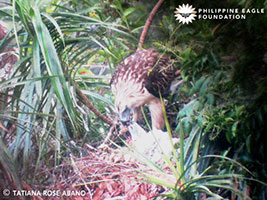
An active Philippine Eagle nest was found in the Cordillera province of Apayao, the first active nest to be found in Luzon.
The nest which was home to a three month-old eaglet and a full-grown Philippine Eagle was a landmark discovery by the Philippine Eagle Foundation or PEF, as a result of a rigorous search that began last 2011 after getting reports of sightings from the Department of Environment and Natural Resources (DENR).
PEF biologist and project coordinator Tatiana Abaño announced last July 14 in Luna town, Apayao province during the Cordillera Day celebrations that the discovery is a good sign that the Cordilleras is a habitat of the national bird which was contrary to previous studies claiming that Western Luzon, including the Cordilleras, was not suitable for the national bird.
Conservationists are hopeful that the discovery of the active nest is a sign that the population of the national bird is growing. The majestic bird that is dubbed as “king of Philippine birds” or “Haribon,” has been listed as critically endangered by the International Union for the Conservation of Nature, with only 400 pairs left in the wild.
The rare bird is known to live in four parts of the nation namely Mindanao region, Samar, Leyte, and now Luzon.
According to PEF reports the three-month old eaglet in the nest is healthy and growing. The eaglet can usually be found perching or focusing in its nest “like a curious baby” said Abaño.
The Cordillera mountain forests is not yet protected on the national level like the Tubbataha
Reefs, Natural Park and Mount Apo. PEF says the recent discovery of the active Philippine Eagle nest may become the stepping stone to push for national protection and more conservation funding.










